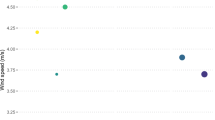Abstract
The incidence and severity of Ascochyta blight in potted chickpea trap plants exposed for 1-wk periods near infested chickpea debris in Córdoba, Spain, or in chickpea trap crops at least 100 m from infested chickpea debris in several locations in southern Spain were correlated with pseudothecial maturity and ascospore production ofDidymella rabiei from nearby chickpea debris. The period of ascospore availability varied from January to May and depended on rain and maturity of pseudothecia. The airborne concentration of ascospores ofD. rabiei was also monitored in 1988. Ascospores were trapped mostly from the beginning of January to late February; this period coincided with that of maturity of pseudothecia on the chickpea debris. Most ascospores were trapped on rainy days during daylight and 70% were trapped between 12.00 and 18.00 h. Autumn-winter sowings of chickpea were exposed longer to ascospore inoculum than the more traditional spring sowings because the autumn-winter sowings were exposed to the entire period of ascospore production on infested chickpea debris lying on the soil surface.
Similar content being viewed by others
References
Aylor DE (1993) Relative collection efficiency of Rotorod and Burkard spore samplers for airborneVenturia inaequalis ascospores. Phytopathology 83: 1116–1119
Aylor DE and Kiyomoto RK (1993) Relationship between aerial concentration ofVenturia inaequalis ascospores and development of apple scab. Agricultural and Forest Metereology 63: 133–147
Fitt BDL and McCartney HA (1986) Spore dispersal in relation to epidemic models. In: Leonard KJ and Fry WE (eds) Plant Disease Epidemiology. Vol. 1 (pp 311–346) MacMillan Publishing Company, New York
Hirst JM (1953) Changes in atmospheric spore content: diurnal periodicity and the effects of weather. Transactions of the British Mycological Society 36: 375–393
Kaiser WJ (1987) Testing and production of healthy plant germplasm. In: Mathur SB and Neergaard P (eds) The Danish Government Institute of Seed Pathology for Developing Countries. Technical Bulletin 2, 30 pp
Kaiser WJ (1992) Epidemiology ofAscochyta rabiei. In: Singh KB and Saxena MC (eds) Disease Resistance Breeding in Kabuli Chickpeas (pp 117–143) ICARDA, Aleppo, Syria
Kovachevski IC (1936) The blight of chickpea (Cicer arietinum L.),Mycosphaerella rabiei n.sp. (In Bulgarian) Ministry of Agriculture and National Domains, Plant Protection Institute, Sofia, Bulgaria. 80 pp
McCartney HA and Lacey ME (1990) The production and release of ascospores ofPyrenopeziza brassicae on oilseed rape. Plant Pathology 39: 17–32
Meredith DS (1973) Significance of spore release and dispersal mechanisms in plant disease epidemiology. Annual Review of Phytopathology 11: 313–342
Navas-Cortés JA (1992) El teleomorfo deAscochyta rabiei en España: Detección, desarrollo y papel en la epidemiología de la Rabia del garbanzo (Cicer arietinum L.). (In Spanish). Ph.D. thesis, University of Córdoba, Spain, 385 pp
Navas-Cortés JA, Trapero-Casas A and Jiménez-Díaz RM (1990) Role of the teleomorph ofAscochyta rabiei in the epidemiology of Ascochyta blight of chickpea in Spain. Proceedings of the 8th Congress Mediterranean Phytopathological Union (pp 289–290), November 1990, Agadir, Morocco
Navas-Cortés JA, Trapero-Casas A and Jiménez-Díaz RM (1995) Survival ofDidymella rabiei in chickpea straw in Spain. Plant Pathology 44: 332–339
Nene YL and Reddy MV (1987) Chickpea diseases and their control. In: Saxena MC and Singh KB (eds) The Chickpea (pp 233–270) Commonwealth Agricultural Bureaux International, Oxon, UK
Rotem J (1988). Quantitative assessment of inoculum production, dispersal, deposition and infectiousness in airborne diseases. In: Kranz J. and Rotem J. (eds) Experimental techniques in plant disease epidemiology (pp 69–83) Springer-Verlag, Berlin
Saxena MC and Singh KB (eds) (1984) Ascochytablight and winter sowing of chickpeas. Martinus Nijhoff/Dr W. Junk Publishers, The Hague. 288 pp
Steel RGD and Torrie JH (1985) Bioestadística. Principios y procedimientos. 2nd ed. McGraw-Hill. 622 pp
Trapero-Casas A and Jiménez-Díaz RM (1986) Influence of sowing date on Fusarium wilt and Ascochyta blight of chickpea in Southern Spain. In: O'Keeffe LE and Muehlbauer FJ (eds) Poster Abstracts, International Food Legume Conference (pp11), College of Agriculture, University of Idaho
Trapero-Casas A and Kaiser WJ (1992a) Influence of temperature, wetness period, plant age, and inoculum concentration on infection and development of Ascochyta blight of chickpea. Phytopathology 82: 589–596
Trapero-Casas A and Kaiser WJ (1992b) Development ofDidymella rabiei, the teleomorph ofAscochyta rabiei, on chickpea straw. Phytopathology 82: 1261–1266
Zachos DG, Panagopoulos CG and Makris SA (1963) Recherches sur la biologie, l'epidemilogie et la lutte contre l'antracnose du pois-chiche. Annals Institute Phytopathology Benaki, NS 5: 167–192
Author information
Authors and Affiliations
Rights and permissions
About this article
Cite this article
Trapero-Casas, A., Navas-Cortés, J.A. & Jiménez-Díaz, R.M. Airborne ascospores ofDidymella rabiei as a major primary inoculum for Ascochyta blight epidemics in chickpea crops in southern Spain. Eur J Plant Pathol 102, 237–245 (1996). https://doi.org/10.1007/BF01877962
Accepted:
Issue Date:
DOI: https://doi.org/10.1007/BF01877962




